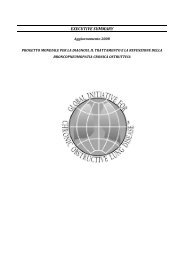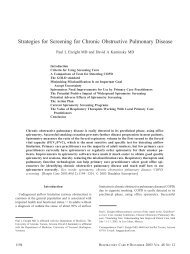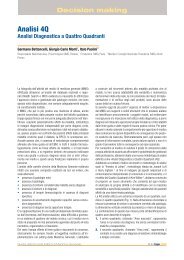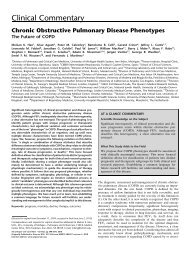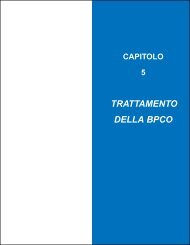Global Initiative for Chronic Obstructive Lung Disease - GOLD
Global Initiative for Chronic Obstructive Lung Disease - GOLD
Global Initiative for Chronic Obstructive Lung Disease - GOLD
Create successful ePaper yourself
Turn your PDF publications into a flip-book with our unique Google optimized e-Paper software.
<strong>GOLD</strong>_WR_05 8/18/05 12:56 PM Page 13<br />
compared to women 3-6 . Gender-related differences in<br />
exposure to risk factors, mostly cigarette smoking,<br />
probably explain this pattern. In developing countries,<br />
some studies report a slightly higher prevalence of COPD<br />
in women than men. This likely reflects exposure to<br />
indoor air pollution from cooking and heating fuels<br />
(greater among women) as well as exposure to tobacco<br />
smoke (greater among men) 7-15 . Recent large populationbased<br />
studies in the US show a different pattern emerging,<br />
with the prevalence of COPD almost equal in men and<br />
women 16,17 . This likely reflects the changing pattern of<br />
exposure to the most important risk factor, tobacco<br />
smoke.<br />
Estimates based on self-report of respiratory symptoms.<br />
COPD prevalence data based on self-report of respiratory<br />
symptoms (chronic cough, sputum production, wheezing,<br />
and shortness of breath) include people at risk <strong>for</strong> COPD<br />
(Stage 0) as well as those with airflow limitation, and thus<br />
yield maximum prevalence estimates. These studies<br />
reveal sizable variations in the prevalence of respiratory<br />
symptoms depending on smoking status, age,<br />
occupational and environmental exposures, country or<br />
region, and, to a lesser extent, gender and race. The<br />
data also reveal appreciable variations over time, reflecting<br />
important temporal changes in populations' exposure to<br />
risk factors such as smoking, outdoor air pollution, and<br />
occupational exposures.<br />
The third National Health and Nutrition Examination<br />
Survey (NHANES 3) 16 , a large national survey conducted<br />
in the US between 1988 and 1994, included self-report<br />
questions about respiratory symptoms. The prevalence<br />
of respiratory symptoms varied markedly by smoking<br />
status (current>ex>never). Among white males, chronic<br />
cough was reported by 24% of smokers, 4.7% of exsmokers,<br />
and 4.0% of never smokers. The prevalence<br />
of chronic cough among white women was 20.6% in<br />
smokers, 6.5% in ex-smokers, and 5.0% in never smokers.<br />
There was a smaller gradient in the prevalence of chronic<br />
cough by race (white>black). The prevalence of sputum<br />
production was similar to that of chronic cough in these<br />
groups.<br />
Estimates based on the presence of airflow limitation.<br />
People may have respiratory symptoms such as cough<br />
and sputum production <strong>for</strong> many years be<strong>for</strong>e developing<br />
airflow limitation. Thus, COPD prevalence data based on<br />
the presence of airflow limitation provide a more accurate<br />
estimate of the burden of COPD that is, or probably soon<br />
will be, clinically significant. However, the use of different<br />
cut points to define airflow limitation makes comparing<br />
the results of different studies difficult.<br />
In the NHANES 3 study 16 , airflow limitation was defined<br />
as an FEV 1 /FVC < 70%. The prevalence of airflow<br />
limitation was lower than the prevalence of respiratory<br />
symptoms found in the same study, but both sets of data<br />
rein<strong>for</strong>ce the view that smoking is the most important<br />
determinant of COPD prevalence in developed countries.<br />
Among white males, airflow limitation was present in<br />
14.2% of current smokers, 6.9% of ex-smokers, and 3.3%<br />
of never smokers. Among white females, the prevalence<br />
of airflow limitation was 13.6% in smokers, 6.8% in exsmokers,<br />
and 3.1% in never smokers. Airflow limitation<br />
was more common among white smokers than among<br />
black smokers.<br />
Estimates based on physician diagnosis of COPD.<br />
COPD prevalence data based on physician diagnosis<br />
provide in<strong>for</strong>mation about the prevalence of clinically<br />
significant COPD that is of sufficient severity to prompt a<br />
visit to a physician. Few population-based prevalence<br />
surveys have been published to provide this in<strong>for</strong>mation,<br />
and available data are often confusing because asthma<br />
and COPD diagnoses are not separated, all age groups<br />
are considered together, or chronic bronchitis and<br />
emphysema are considered separately.<br />
In the UK the General Practice Research Database 18 ,<br />
which is based on 525 practices serving 3.4 million<br />
patients (6.4% of the total population of England and<br />
Wales), provides population-based data on physiciandiagnosed<br />
COPD (Figure 2-1). In 1997, the prevalence<br />
of COPD was 1.7% among men and 1.4% among<br />
women. Between 1990 and 1997, the prevalence<br />
increased by 25% in men and 69% in women. The<br />
prevalence of COPD among men plateaued in the mid-<br />
1990s, but continued to increase among women, reaching<br />
Figure 2-1. Prevalence (%) of Physician-Diagnosed<br />
COPD in the UK From 1990 to 1997 by Sex 18<br />
2.0<br />
1.5<br />
1.0<br />
0.5<br />
0.0<br />
1990<br />
1991<br />
1992<br />
Men<br />
1993<br />
1994<br />
1995<br />
1996<br />
Women<br />
1997<br />
Reprinted with permission from Soriano JR, Maier WC, Egger R, Visick G, Thakrar B, Sykes J,<br />
et al. Thorax 2000; 55:789-94. Copyright 2000 BMJ Publishing Group.<br />
BURDEN OF COPD 13


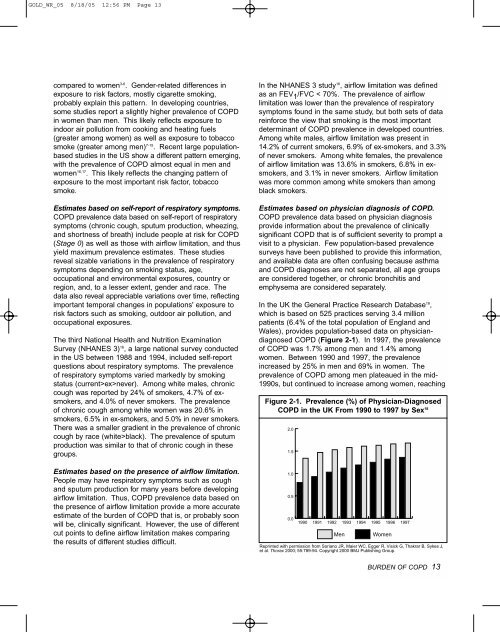


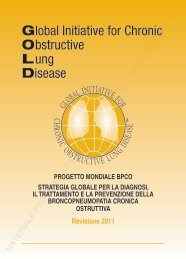
![Di Bari [NO].pdf - GOLD](https://img.yumpu.com/21544924/1/190x143/di-bari-nopdf-gold.jpg?quality=85)

